Asaf Ali’s Haveli
The hidden history of a girls’ primary school in Old Delhi
 TCA Raghavan
TCA Raghavan
 TCA Raghavan
TCA Raghavan
 |
11 Aug, 2022
|
11 Aug, 2022
/wp-content/uploads/2022/08/AsafAli1.jpg)
A painting of Delhi being recaptured by the East India Company’s armies in 1857
ASAF ALI’S HAVELI NO LONGER EXISTS and a primary girls’ school run by the municipality occupies its site. Yet its memory has endured and its story survives as a mute witness of the twists and turns of India’s colonial history and the violence at its beginning and end. The haveli, inside the walled city of Old Delhi, is where the nationalist and Congressman Asaf Ali was born and lived. He is not entirely forgotten and during his lifetime was by no means a subaltern figure in the quarter century before 1947. At the time of Independence, he was India’s first ambassador to the US and before that had served briefly as a minister in the Interim Government. Jailed a number of times, a Muslim leader from Hindu-majority Delhi, he was a Congress loyalist in that small group of ‘nationalist Muslims’ which formed one basis of the Congress claim to the Muslim League that it represented all Indians regardless of religion. And yet, Asaf Ali is not in the marquee list of the principal characters of the time, although his contribution was significant.
This haveli was his mother’s paternal home. Before he was born, she had refused to accept her husband’s taking of a second wife and moved back to live with her parents. Theirs was a large and spacious haveli in Daryaganj, a short walk from both the Jama Masjid and the Red Fort, and probably built in the reign of Mughal Emperor Akbar II (1806-37). The locality it is located in is Kucha Chelan, possibly so named because the disciples (chelas) of a Pir sometime resided there. Or possibly derived from Kucha Chelan Amiran—suggesting that this was the area where Amirs or major courtiers had lived.
II
Kucha Chelan was the location of one of the many terrible massacres of Dehi’s population when the city was retaken by the East India Company’s armies in 1857. Over a thousand males in the locality were slaughtered in its lanes; many others were marched to the banks of the Jamuna, and shot there, their bodies dumped into the river. It was only one more tragedy in the aftermath of what is often described as the largest revolt against European imperialism in the 19th century. It is events such as these, seared into popular memory, that give the blood and feeling to the larger narratives of history. In one account, after the killing of the men, “many of their women were in such despair by what they saw that they left their houses with their children and jumped into the wells of Kucha Chelan”. The writer of these lines, an eyewitness, concluded, “My pen refuses to write further”. Asaf Ali later recalled that he grew up with stories such as “no less than two hundred persons who had taken shelter…were put to the sword in the spacious courtyards and halls of this house.”
It was also the massacre of a culture. Among those killed in Kucha Chelan were the flowers of Delhi’s intellectuals, for instance Mir Niyaz Ali, a storyteller; or Miyan Amir Panjabash, the calligrapher—men who “were the pride of Delhi”. Most prominent among those killed on the banks of the Jamuna was the renowned Persian scholar Imam Baksh Sehbai, who was possibly the original owner of the haveli. The Imam had been a teacher of Persian at the Delhi College and was a prolific writer. Such was Imam Baksh’s centrality as a literary figure, that some two decades later former students and admirers—both Hindus and Muslims— published his writings in the form of a collected works.
According to the family lore that Asaf Ali grew up with, Imam Baksh’s haveli, as possibly others in the locality, was auctioned once the situation had stabilised sufficiently in the estimation of the British. After the city was retaken, it was substantially emptied of its population. In this, the Muslims were targeted in particular—for most British observers a Muslim meant a rebel. Amongst those forced out was Asaf’s maternal grandmother “who never spoke of those days…without bitter tears”, and her family; the city they returned to was referred to as “Shahr ujre bad” (the city after the uprooting). On her return, she was married and it was her husband, possibly a loyalist who had served in the Company’s army, who acquired the haveli in the auction.
In Asaf Ali’s words, “[T]he ghosts if any of those massacred did not bother the new owners, but their memory haunted the place every time the word ghadr was mentioned.” Certainly 1857 cast a long shadow and Asaf Ali, as he embarked on his own voyage into Indian nationalism from the mid-1910s, remembered “how my maternal grandmother used to tremble at the very mention of anti-government agitation.” Living in Kucha Chelan possibly did that to many people.
The haveli itself soon had a new name after Asaf Ali had qualified at the Bar in London and became gradually prominent in Delhi’s political life. It was henceforth known as “Barrister Asaf Ali’s haveli”. His bride, Aruna Gangulee, was to make this her home too when they were married in 1927. The marriage was controversial not only because of the over 20 years that separated them but also because it was between a Hindu and a Muslim. She was a convent-educated, Westernised 18-year-old brought up to speak English with the ‘correct accent’. Adjusting to the medieval world of Kucha Chelan, both in terms of its mindset as also its material conditions, would not have been easy. Asaf had suggested that they live elsewhere in a modern flat in the Civil Lines area but Aruna would have none of it. In time, she would become in her own right a radical face of the Indian national movement.
III
Nine decades after the 1857 massacre, the haveli was once more at the centre of history in the second half of 1945. In mid-June, the nationalist leadership—principally then of the Indian National Congress—had just been released from prisons across the country. Asaf Ali was released from Gurudaspur but he had spent virtually his entire captivity in the Nizamshahi fortress at Ahmednagar, jailed in a British military garrison along with the rest of the Congress Working Committee (CWC).
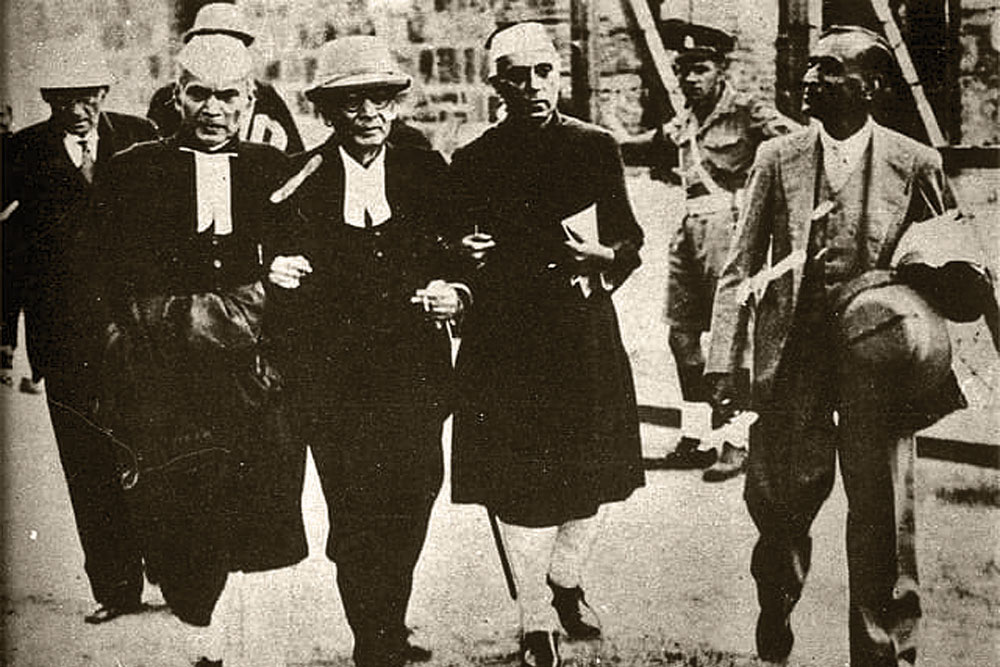
The world had changed since their arrest in August 1942 at the launch of the Quit India Movement in Bombay. The war in Europe had come to an end with Germany’s surrender on May 8, 1945.The war in East and Southeast Asia continued but its trajectory and outcome were clear with Japan’s comprehensive defeat now imminent. A clear reminder of how much things had changed came from the results of the British General Election in end-July 1945. The Conservatives were routed and Churchill the war hero voted out. The Labour Party would form the new government and its view on India was clear: British rule should now end quickly, and sooner rather than later. Japan announced its surrender on August 15, after the deployment of nuclear bombs in Hiroshima and Nagasaki. Subhas Chandra Bose was killed in an air crash on August 18. On August 21, immediately after the Japanese surrender, came announcements from the Government of India of elections to the Central and Provincial Legislatures and that the next step would be the construction of a new architecture of governance for a new and independent India by drafting a constitution for the country.
Subhas Bose’s call ‘Dilli Chalo’ invoked the INA marching to the gates of the Red Fort. The trial of its officers in that very fort had thus all the ingredients to symbolically link the INA to India’s First War of Independence when Bahadur Shah, howsoever formally, was at the head of the first national effort to rid the country of foreign rule
Asaf was the natural choice for the Delhi seat to the Central Legislature: he was certainly now the most prominent local face of the party and perhaps of the national movement as a whole in Delhi. His old haveli must have been at the bustling centre of his poll campaign. The outcome of the election itself was largely a foregone conclusion. Delhi was not a reserved Muslim seat but a general constituency; the Muslim League did not put up an official candidate but it did informally back a Muslim contender against Asaf. The Hindu Mahasabha put up a candidate who lost his deposit. The electorate was small and Asaf secured over 6,000 votes as compared to his Muslim rival who got about 1,500. Congress had however taken no chances in Delhi. This was a prestige seat and Asaf was now one of its prominent faces and the election campaign was inaugurated by Jawaharlal Nehru himself.
Although the election was described as a “tame affair”, it nevertheless had its intense moments, including personal attacks on Asaf by the League: “One League journal reminds Congress Muslims that Mrs Aruna Asaf Ali is still out of purdah and nobody knows whether she has accepted Islam or not.” Such carping notwithstanding, the clarity of the verdict made the whole process appear a formality. One news report summed up the result as follows. Asaf, it wrote, “represents the fastly vanishing Delhi culture.” If there was little doubt about his popularity, it continued, “His wife, the gallant, charming and never surrender Aruna Asaf Ali has further added to his popularity”. The conclusion for this journalist at least was inescapable: “Yes, People voted for Asaf because he was a Congress candidate, because he was Asaf and because of Aruna Asaf Ali.” She was, incidentally, not by his side but still underground as she had been since August 1942. This, however, is the story of Asaf’s house and not of his wife.
Through the election campaign there had been another, and perhaps more significant, factor that had gripped the popular imagination and Asaf, perhaps fortuitously, found himself at the centre of it. At about the time the new Labour government in London was changing tack from its predecessor on the question of Indian independence came the decision to court martial and convict those who had supported the Japanese war effort by joining the Indian National Army (INA).
The first error of judgement the colonial government made was to fix the trial by court martial in the historic Red Fort of Delhi. The next was to select—so as not to appear discriminatory— a Hindu, a Sikh and a Muslim officer for the first trial. Underwriting these decisions was the greater error of misreading how much of an emotional and nationalist issue the INA trial would become. And so it was that Gurbaksh Singh Dhillon, Shah Nawaz Khan and Prem Sahgal were charged with murder, abetment to murder, and waging war against the King.
Almost from the start, public comments drew comparison with an equally symbolic, and often remembered as one-sided, trial at the Red Fort—that of the deposed Mughal Emperor Bahadur Shah Zafar charged with mutiny and exiled for life to Rangoon. Subhas Bose had visited his tomb after Burma fell to Japanese forces. His call “Dilli Chalo” invoked the INA marching to the gates of the Red Fort. The trial of its officers in that very fort had thus all the ingredients to symbolically link the INA to India’s First War of Independence when Bahadur Shah, howsoever formally, was at the head of the first national effort to rid the country of foreign rule.
Congress soon announced the formation of a Defence Committee to see that these “patriotic men were properly defended”. The Defence Committee consisted of a number of legal and political luminaries, including Nehru, Tej Bahadur Sapru, Bhulabhai Desai and others, with Asaf Ali as the convener. Asaf seems to have been an automatic choice—he was in the CWC, was a Delhi-based lawyer and therefore in a position to follow up on a daily basis. He would have no doubt foreseen that time devoted to this cause was not a diversion from his own election campaign but supplemented it.
Asaf’s role in the actual legal proceedings need not be overstated. The defence was led by Bhulabhai Desai who presented virtually all arguments himself. The entire team, including Nehru and Sapru, were present on the opening day and an iconic photograph marks the occasion. But thereafter it was really Desai who was the main player. Asaf was present through the entire trial but was silent except for one cross examination where he had a testy exchange with the prosecution lawyer. The proceedings, however, were as much optical and political as legal, and the press reports portray Asaf throughout as a vital member of the defence.
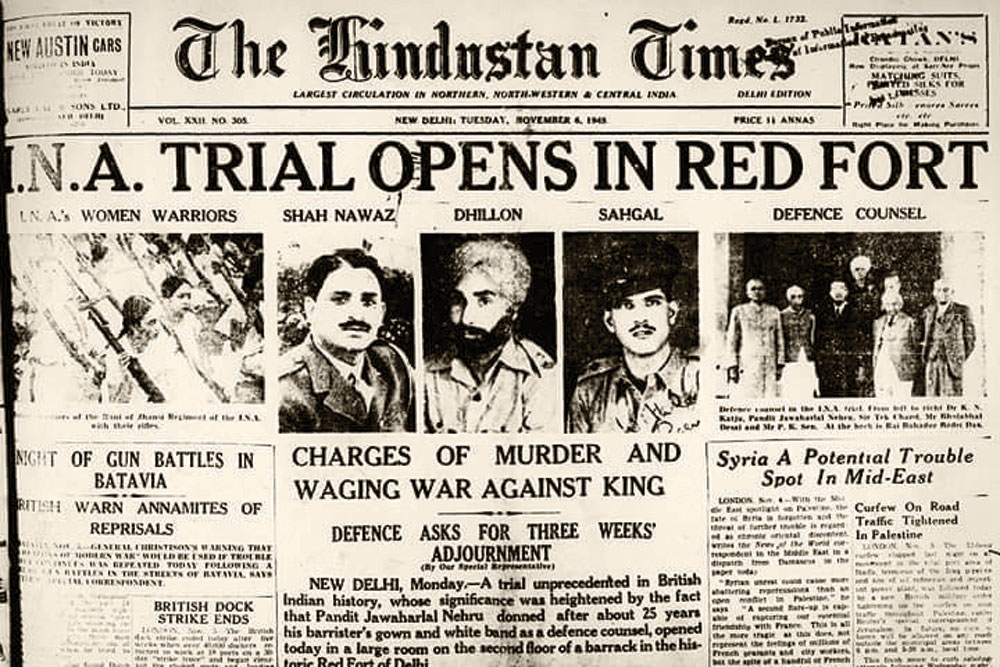
The final verdict was as expected but the outcome was not: the three officers were found guilty of waging war against the King but not of murder or abetment to commit murder. The sentences awarded were dismissal from service with forfeiture of pay and allowances and transportation for life. The real fear of a massive public outcry and of a popular upsurge that might infect the entire machinery of government led to the sentence of transportation being remitted. In effect, the three officers were free to walk out and that is what they did. For the public and nationalists of all hues, it was a great victory.
On being released on January 3, 1946 amongst the first places the three officers went to was Asaf’s haveli in Kucha Chelan. As they passed through the narrow streets of the old city, word spread and, by the time they reached his house, a large crowd was present. In one account: “Joyously they marched in, followed by a crowd of friends and admirers loaded with sweets and garlands”. Another report described the scene: “…crowds gathered in the narrow valley (sic) of Kucha Chelan in which the house stood and for the next hour or two the INA men were caught in a wave of public enthusiasm. As they came out of the house the crowd cheered them with cries of “Jai Hind” and “Inquilab Zindabad”.
The massacre at Kucha Chelan in 1857 would have appeared to have been finally avenged when the three INA officers released after the trial walked from Red Fort to Daryaganj as they went to Asaf ’s house. And now, you had again frightened people huddled together in the precincts of the old structure in the midst of another great ferment reminiscent of the 1857 upheaval
There must have been some residents of the locality who would have juxtaposed the scenes before them with the memories they had inherited and the lore they had been brought up on of the massacre carried out in Kucha Chelan by vengeful British troops as the city was retaken and then sacked in 1857. Certainly, where the memories of that assertion of the might of empire still existed, the current scenes would convince even the most sceptical that “anticipations of freedom” were not now unfounded, and that the arc of justice may have been long but it had finally bent in their direction.
IV
Asaf Ali would not stay much longer in Kucha Chelan. The haveli had been falling into a state of disrepair after his mother’s death in 1941 and during his long imprisonment from August 1942. As a member of the Central Legislature, he was allotted and moved into 2 Windsor Place, a government bungalow in New Delhi. But the Kucha Chelan haveli also remained his address as it did for Aruna Asaf Ali when she ended her underground existence in April 1946 once the arrest warrant against her was withdrawn. By January 1947, Asaf was in the US as India’s first ambassador, even though India was not yet legally a fully sovereign entity.
In late August 1947, he was on his way back to India—ostensibly for consultations, but perhaps he was desperate to come and see for himself what was happening in Delhi and to get a firmer sense of the India-wide situation. As ambassador, putting a brave face on distressing developments in your country comes with the territory. Certainly, he also endeavoured to do so. At a meeting with the press during the stopover in London en route to Delhi, he was arguing that the violence in Punjab was the work of “insane reactionaries” and that “he was sure the violence would end after transfer of power had become an accepted fact”. His defensiveness was however evident and perhaps, as ambassador, inevitable; or perhaps he was still unable to grasp the magnitude of what was underway. And yet, Asaf was possibly also trying to convince himself that things could not be as dire as was being made out when he described “newspaper reports as exaggerated”.
He spent about three weeks in Delhi but there is little we know about his thoughts on the mayhem that was continuing in the city as he appears to have left no record of it. Perhaps the trauma he encountered was simply too close and too great for this to happen.
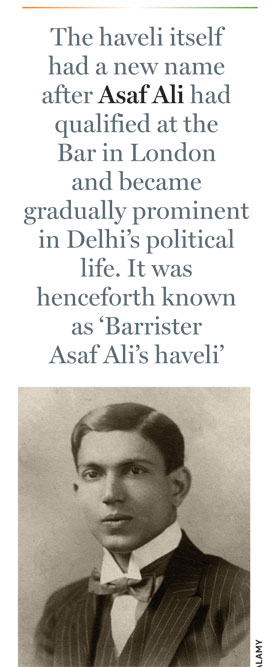
Police firings, curfews, rioting, looting and stabbings, trains and buses and also groups of refugees being attacked, make up a good part of the newspapers of August and September 1947. The atmosphere was so polarised that rumours soon circulated that Asaf had been recalled from Washington because it was feared that his real loyalties were to Pakistan. These rumours had to be dispelled by Mahatma Gandhi himself at one of his prayer meetings in September.
Perhaps even worse than this questioning of his loyalty to India were the events at his home the same month, Asaf’s old house in Kucha Chelan had also become the site of a scene that was recurring repeatedly across the city and in many parts of north India. About a hundred Muslims of the locality—perhaps more—are reported as having taken shelter in it. The rundown haveli was still ‘Barrister Asaf Khan’s haveli’ and those who took shelter in it possibly felt that they would be safer there because of the stature and high position of its owner. Their gathering was also unusual because Gandhi himself went to meet and reassure them of their safety on September 18, 1947. Press reports do not mention Asaf Ali’s presence—perhaps he had already left for the US—or whether it was at his entreaty that Gandhi went there in particular to meet the beleaguered group when there were thousands like them across the country. Undoubtedly, Asaf would have come to know of this occurrence and the poignancy of the occasion would not have been lost on him.
How quickly and frequently history changes direction; history, like progress, is hardly ever linear. The massacre at Kucha Chelan in 1857 would have appeared to have been finally avenged when just a few months earlier the three INA officers released after the trial walked from the Red Fort to Daryaganj, cheered by local residents as they went to Asaf’s house. And now, you had again desperate, frightened people huddled together in the precincts of the old structure in the midst of another great ferment reminiscent, at least in part, of the 1857 upheaval. That one location gives rise to many thoughts on the different meanings of freedom and Partition and loyalty.
V
When Asaf Ali died in 1953 he was India’s ambassador to Switzerland. Nehru wrote poignantly about him as someone who carried, because of the events of 1947, “many a wound in the recess of his heart”. The shock of Partition, Nehru wrote, “and the changes this had brought about in the texture of life in Delhi” gave Asaf Ali “a somewhat lost look as if he was missing something he was used to”.
The primary girls’ school has no name and possibly it has never occurred to the municipality to name it after Asaf or Aruna Asaf Ali, or to put up a plaque highlighting the association or the hidden history of the site itself. It is unlikely to happen now. There is much at Kucha Chelan itself that has changed and only the barest memory of its turbulent past endures. But certainly, as we come up to the 75th anniversary of Independence, it is appropriate to recall the tragedy and triumph that has characterised India’s last two centuries. Not only the violent beginning and end of colonialism in India, but the moments of elation and victory, of hope in a new beginning, of the belief that a new nation can rise above its old adversities—all of which have been witnessed in this obscure, neglected corner of Daryaganj in Old Delhi

/wp-content/uploads/2025/07/Cover_Dalai-Lama.jpg)






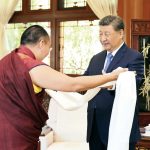

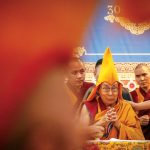

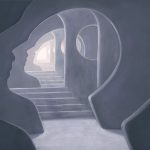

More Columns
The brilliant bowlers of Birmingham Aditya Iyer
Beijing Wants a Monk In Marionette Strings Kush Sharma
Alongside Dharavi Recast, Adani Lines Up Goregaon, Malad, BKC Slum Clusters Fast-Fast! Short Post